Predicting the Potential Suitable Climate for Coconut (Cocos nucifera L.) Cultivation in India under Climate Change Scenarios Using the MaxEnt Model
Abstract
1. Introduction
2. Methods
2.1. Study Area
2.2. Coconut Occurrence Data
2.3. Selection of Environmental Variables
2.4. Model
2.5. Model Calibration
2.6. Model Evaluation
2.7. Threshold Selection
3. Results
3.1. Outcome of Model Calibration
3.2. Model Evaluation
3.3. Predictor Variable Influence
3.4. Regional Changes in Predictor Variables
3.5. Current and Future Projections
3.6. Changes in Coconut Habitat Suitability
4. Discussion
5. Conclusions
Author Contributions
Funding
Institutional Review Board Statement
Informed Consent Statement
Data Availability Statement
Acknowledgments
Conflicts of Interest
References
- APCC. Coconut Statistical Yearbook; Asian and Pacific Coconut Community: Jakarta, Indonesia, 2015; 288p. [Google Scholar]
- Omont, H. Information Sheet-COCONUT; IPGRI—Commodity Chains; FAO: Rome, Italy, 2001. [Google Scholar]
- Rethinam, P. International Scenario of Coconut Sector. In The Coconut Palm (Cocos nucifera L.)—Research and Development Perspectives; Nampoothiri, K.U.K., Krishnakumar, V., Thampan, P.K., Nair, M.A., Eds.; Springer: Singapore, 2018; pp. 21–56. [Google Scholar]
- Ramesh, S.V.; Pandiselvam, R.; Thushara, R.; Manikantan, M.R.; Hebbar, K.B.; Beegum, S.; Mathew, A.C.; Neenu, S.; Shil, S. Engineering intervention for production of virgin coconut oil by hot process and multivariate analysis of quality attributes of virgin coconut oil extracted by various methods. J. Food Process Eng. 2020, 43, e13395. [Google Scholar] [CrossRef]
- Hebbar, K.B.; Arivalagan, M.; Manikantan, M.R.; Mathew, A.C.; Thamban, C.; Thomas, G.V.; Chowdappa, P. Coconut inflorescence sap and its value addition as sugar—Collection techniques, yield, properties and market perspective. Curr. Sci. 2015, 109, 1411–1417. [Google Scholar] [CrossRef]
- Hebbar, K.B.; Arivalagan, M.; Pavithra, K.C.; Roy, T.K.; Gopal, M.; Shivashankara, K.S.; Chowdappa, P. Nutritional profiling of coconut (Cocos nucifera L.) inflorescence sap collected using novel coco-sap chiller method and its value added products. J. Food Meas. Charact. 2020, 14, 2703–2712. [Google Scholar] [CrossRef]
- Asghar, M.T.; Yusof, Y.A.; Mokhtar, M.N.; Ya’acob, M.E.; Mohd. Ghazali, H.; Chang, L.S.; Manaf, Y.N. Coconut (Cocos nucifera L.) sap as a potential source of sugar: Antioxidant and nutritional properties. Food Sci. Nutr. 2020, 8, 1777–1787. [Google Scholar] [CrossRef]
- Joshi, S.; Kaushik, V.; Gode, V.; Mhaskar, S. Coconut Oil and Immunity: What do we really know about it so far? J. Assoc. Phys. India 2020, 68, 67–72. [Google Scholar]
- Ramesh, S.V.; Krishnan, V.; Praveen, S.; Hebbar, K.B. Dietary prospects of coconut oil for the prevention and treatment of Alzheimer’s disease (AD): A review of recent evidences. Trends Food Sci. Technol. 2021, 112, 201–211. [Google Scholar] [CrossRef]
- Jose, T.K. Let’s ‘Make in India’ futuristic coconut products. Indian Coconut J. 2015, 28, 1. [Google Scholar]
- OECD-FAO. Agricultural Outlook 2017–2026; OECD: Paris, France, 2017. [Google Scholar]
- Pachauri, R.K.; Allen, M.R.; Barros, V.R.; Broome, J.; Cramer, W.; Christ, R.; Church, J.A.; Clarke, L.; Dahe, Q.; Dasgupta, P.; et al. Climate Change 2014: Synthesis Report. Contribution of Working Groups I, II and III to the Fifth Assessment Report of the Intergovernmental Panel on Climate Change; IPCC: Geneva, Switzerland, 2014; 151p. [Google Scholar]
- Kumar, S.N.; Bai, K.V.K.; Rajagopal, V.; Aggarwal, P.K. Simulating coconut growth, development and yield with the InfoCrop-coconut model (Tree Physiology 28 (1049–1058)). Tree Physiol. 2009, 29, 751. [Google Scholar] [CrossRef][Green Version]
- Wilson, C.D.; Roberts, D.; Reid, N. Applying species distribution modelling to identify areas of high conservation value for endangered species: A case study using Margaritifera (L.). Biol. Conserv. 2011, 144, 821–829. [Google Scholar] [CrossRef]
- Hebbar, K.B.; Santhosh, A.; Sukumar, A.P.; Neethu, P.; Ramesh, S.V.; Selvamani, V. Effect of sea water substitution on growth, physiological and biochemical processes of coconut (Cocos nucifera L.) seedlings—A hydroponic study. Sci. Hortic. (Amst.) 2021, 280, 109935. [Google Scholar] [CrossRef]
- Walther, G.R.; Post, E.; Convey, P.; Menzel, A.; Parmesan, C.; Beebee, T.J.C.; Fromentin, J.M.; Hoegh-Guldberg, O.; Bairlein, F. Ecological responses to recent climate change. Nature 2002, 416, 389–395. [Google Scholar] [CrossRef] [PubMed]
- Parmesan, C.; Yohe, G. A globally coherent fingerprint of climate change impacts across natural systems. Nature 2003, 421, 37–42. [Google Scholar] [CrossRef] [PubMed]
- Bellard, C.; Bertelsmeier, C.; Leadley, P.; Thuiller, W.; Courchamp, F. Impacts of climate change on the future of biodiversity. Ecol. Lett. 2012, 15, 365–377. [Google Scholar] [CrossRef] [PubMed]
- Staudinger, M.D.; Grimm, N.B.; Staudt, A.; Carter, S.F.; Chapin, F.S.; Kareiva, P.; Ruckelshaus, M.; Stein, B.A. Impacts of climate change on biodiversity, ecosystems, and ecosystem services: Technical input to the 2013 National Climate Assessment. In Cooperative Report to the 2013 National Climate Assessment; Global Change Research Program: Washington, DC, USA, 2012; 296p. [Google Scholar]
- Hebbar, K.B.; Sheena, T.L.; Kumari, K.S.; Padmanabhan, S.; Balasimha, D.; Kumar, M.; Thomas, G.V. Response of coconut seedlings to elevated CO2 and high temperature in drought and high nutrient conditions. J. Plant. Crop. 2013, 41, 118–122. [Google Scholar]
- Norby, R.J.; DeLucia, E.H.; Gielen, B.; Calfapietra, C.; Giardina, C.P.; Kings, J.S.; Ledford, J.; McCarthy, H.R.; Moore, D.J.P.; Ceulemans, R.; et al. Forest response to elevated CO2 is conserved across a broad range of productivity. Proc. Natl. Acad. Sci. USA 2005, 102, 18052–18056. [Google Scholar] [CrossRef]
- Hebbar, K.B.; Rose, H.M.; Nair, A.R.; Kannan, S.; Niral, V.; Arivalagan, M.; Gupta, A.; Samsudeen, K.; Chandran, K.P.; Chowdappa, P.; et al. Differences in In Vitro Pollen Germination and Pollen tube Growth of Coconut (Cocos nucifera L.) Cultivars in Response to High Temperature Stress; Elsevier B.V.: Amsterdam, The Netherlands, 2018; Volume 153, ISBN 9149942328. [Google Scholar]
- Hebbar, K.B.; Neethu, P.; Sukumar, P.A.; Sujithra, M.; Santhosh, A.; Ramesh, S.V.; Niral, V.; Hareesh, G.S.; Nameer, P.O.; Prasad, P.V.V. Understanding physiology and impacts of high temperature stress on the progamic phase of coconut (Cocos nucifera L.). Plants 2020, 9, 1651. [Google Scholar] [CrossRef]
- Oren, R.; Ellsworth, D.S.; Johnsen, K.H.; Phillips, N.; Ewers, B.E.; Maier, C.; Schäfer, K.V.R.; McCarthy, H.; Hendrey, G.; McNulty, S.G.; et al. Soil fertility limits carbon sequestration by forest ecosystems in a CO2-enriched atmosphere. Nature 2001, 411, 469–472. [Google Scholar] [CrossRef]
- Reich, P.B.; Luo, Y.; Bradford, J.B.; Poorter, H.; Perry, C.H.; Oleksyn, J. Temperature drives global patterns in forest biomass distribution in leaves, stems, and roots. Proc. Natl. Acad. Sci. USA 2014, 111, 13721–13726. [Google Scholar] [CrossRef]
- Hebbar, K.B.; Apshara, E.; Chandran, K.P.; Prasad, P.V.V. Effect of elevated CO2, high temperature, and water deficit on growth, photosynthesis, and whole plant water use efficiency of cocoa (Theobroma cacao L.). Int. J. Biometeorol. 2020, 64, 47–57. [Google Scholar] [CrossRef]
- Phillips, S.J.; Dudík, M.; Schapire, R.E.; Internet. Maxent Software for Modeling Species Niches and Distributions (Version 3.4.1). Available online: http://biodiversityinformatics.amnh.org/open_source/maxent/ (accessed on 15 October 2020).
- Elith, J.; Graham, C.H.; Anderson, R.P.; Dudík, M.; Ferrier, S.; Guisan, A.; Hijmans, R.J.; Huettmann, F.; Leathwick, J.R.; Lehmann, A.; et al. Novel methods improve prediction of species’ distributions from occurrence data. Ecography 2006, 29, 129–151. [Google Scholar] [CrossRef]
- Pearson, R.G.; Dawson, T.P. Predicting the impacts of climate change on the distribution of species: Are bioclimate envelope models useful? Glob. Ecol. Biogeogr. 2003, 12, 361–371. [Google Scholar] [CrossRef]
- Braunisch, V.; Coppes, J.; Arlettaz, R.; Suchant, R.; Schmid, H.; Bollmann, K. Selecting from correlated climate variables: A major source of uncertainty for predicting species distributions under climate change. Ecography 2013, 36, 971–983. [Google Scholar] [CrossRef]
- Yang, X.-Q.; Kushwaha, S.P.S.; Saran, S.; Xi, J.; Roy, P.S. Maxent modeling for predicting the potential distribution of medicinal plant, Justicia adhatoda L. in Lesser Himalayan foothill. Ecol. Eng. 2013, 15, 83–87. [Google Scholar] [CrossRef]
- Searcy, C.A.; Shaffer, H.B. Do ecological niche models accurately identify climatic determinants of species ranges? Am. Nat. 2016, 187, 423–435. [Google Scholar] [CrossRef]
- Läderach, P.; Martinez-Valle, A.; Schroth, G.; Castro, N. Predicting the future climatic suitability for cocoa farming of the world’s leading producer countries, Ghana and Côte d’Ivoire. Clim. Chang. 2013, 119, 841–854. [Google Scholar] [CrossRef]
- Schroth, G.; Läderach, P.; Martinez-Valle, A.I.; Bunn, C.; Jassogne, L. Vulnerability to climate change of cocoa in West Africa: Patterns, opportunities and limits to adaptation. Sci. Total Environ. 2016, 556, 231–241. [Google Scholar] [CrossRef]
- Pham, Y.; Reardon-Smith, K.; Mushtaq, S.; Cockfield, G. The impact of climate change and variability on coffee production: A systematic review. Clim. Chang. 2019, 156, 609–630. [Google Scholar] [CrossRef]
- Kogo, B.K.; Kumar, L.; Koech, R.; Kariyawasam, C.S. Modelling climate suitability for rainfed Maize cultivation in Kenya using a Maximum Entropy (MaxENT) approach. Agronomy 2019, 9, 727. [Google Scholar] [CrossRef]
- He, Q.; Zhou, G. Climate-associated distribution of summer maize in China from 1961 to 2010. Agric. Ecosyst. Environ. 2016, 232, 326–335. [Google Scholar] [CrossRef]
- Jayasinghe, S.L.; Kumar, L. Modeling the climate suitability of tea [Camellia sinensis (L.) O. Kuntze] in Sri Lanka in response to current and future climate change scenarios. Agric. For. Meteorol. 2019, 272, 102–117. [Google Scholar] [CrossRef]
- Cobos, M.E.; Townsend Peterson, A.; Barve, N.; Osorio-Olvera, L. Kuenm: An R package for detailed development of ecological niche models using Maxent. PeerJ 2019, 7, e6281. [Google Scholar] [CrossRef] [PubMed]
- Brown, J.L.; Bennett, J.R.; French, C.M. SDMtoolbox 2.0: The next generation Python-based GIS toolkit for landscape genetic, biogeographic and species distribution model analyses. PeerJ 2017, 5, e4095. [Google Scholar] [CrossRef] [PubMed]
- Brown, J.L.; Hill, D.J.; Dolan, A.M.; Carnaval, A.C.; Haywood, A.M. Paleoclim, high spatial resolution paleoclimate surfaces for global land areas. Sci. Data 2018, 5, 180254. [Google Scholar] [CrossRef]
- Hijmans, R.J.; Cameron, S.E.; Parra, J.L.; Jones, P.G.; Jarvis, A. Very high resolution interpolated climate surfaces for global land areas. Int. J. Climatol. 2005, 25, 1965–1978. [Google Scholar] [CrossRef]
- Remya, K.; Ramachandran, A.; Jayakumar, S. Predicting the current and future suitable habitat distribution of Myristicadactyloides Gaertn. Using MaxEnt model in the Eastern Ghats, India. Ecol. Eng. 2015, 82, 184–188. [Google Scholar] [CrossRef]
- Jose, V.S.; Nameer, P.O. The expanding distribution of the Indian Peafowl (Pavocristatus) as an indicator of changing climate in Kerala, southern India: A modelling study using MaxEnt. Ecol. Indic. 2020, 110, 105930. [Google Scholar] [CrossRef]
- Mod, H.K.; Scherrer, D.; Luoto, M.; Guisan, A. What we use is not what we know: Environmental predictors in plant distribution models. J. Veg. Sci. 2016, 27, 1308–1322. [Google Scholar] [CrossRef]
- Shabani, F.; Ahmadi, M.; Kumar, L.; Solhjouy-Fard, S.; Tehrany, M.S.; Shabani, F.; Kalantar, B.; Esmaeili, A. Invasive weed species’ threats to global biodiversity: Future scenarios of changes in the number of invasive species in a changing climate. Ecol. Indic. 2020, 116, 106436. [Google Scholar] [CrossRef]
- Jaynes, E.T. Information Theory and Statistical Mechanics. Phys. Rev. 1957, 106, 620–630. [Google Scholar] [CrossRef]
- Phillips, S.J.; Anderson, R.P.; Schapire, R.E. Maximum entropy modeling of species geographic distributions. Ecol. Model. 2006, 190, 231–259. [Google Scholar] [CrossRef]
- Phillips, S.J.; Dudík, M. Modeling of species distribution with MaxEnt: New extensions and a comprehensive evaluation. Ecography 2008, 31, 161–175. [Google Scholar] [CrossRef]
- O’Donnell, M.S.; Ignizio, D.A. Bioclimatic Predictors for Supporting Ecological Applications in the Conterminous United States. US Geol. Surv. Data Ser. 2012, 691, 4–9. [Google Scholar]
- Merow, C.; Smith, M.J.; Silander, J.A. A practical guide to MaxEnt for modeling species’ distributions: What it does, and why inputs and settings matter. Ecography 2013, 36, 1058–1069. [Google Scholar] [CrossRef]
- Phillips, S.J.; Dudík, M.; Schapire, R.E. A maximum entropy approach to species distribution modeling. In Proceedings of the Twenty-First International Conference on Machine Learning, Banff, AB, Canada, 4–8 July 2004; ACM Press: New York, NY, USA, 2004; pp. 655–662. [Google Scholar]
- Al Ruheili, A.M.; Boluwade, A.; Al Subhi, A.M. Assessing the impact of climate change on the distribution of lime (16SRII-b) and alfalfa (16srii-d) phytoplasma disease using maxent. Plants 2021, 10, 460. [Google Scholar] [CrossRef] [PubMed]
- Liu, C.; Newell, G.; White, M. On the selection of thresholds for predicting species occurrence with presence-only data. Ecol. Evol. 2016, 6, 337–348. [Google Scholar] [CrossRef] [PubMed]
- Davies, T.J.; Purvis, A.; Gittleman, J.L. Quaternary climate change and the geographic ranges of mammals. Am. Nat. 2009, 174, 297–307. [Google Scholar] [CrossRef]
- Zhang, L.; Cao, B.; Bai, C.; Li, G.; Mao, M. Predicting suitable cultivation regions of medicinal plants with Maxent modeling and fuzzy logics: A case study of Scutellaria baicalensis in China. Environ. Earth Sci. 2016, 75, 361. [Google Scholar] [CrossRef]
- Xu, X.; Zhang, H.; Yue, J.; Xie, T.; Xu, Y.; Tian, Y. Predicting shifts in the suitable climatic distribution of walnut (Juglans regia L.) in China: Maximum entropy model paves the way to forest management. Forests 2018, 9, 103. [Google Scholar] [CrossRef]
- Kelly, A.E.; Goulden, M.L. Rapid shifts in plant distribution with recent climate change. Proc. Natl. Acad. Sci. USA 2008, 105, 11823–11826. [Google Scholar] [CrossRef]
- Blach-Overgaard, A.; Svenning, J.-C.; Balslev, H. Climate change sensitivity of the African ivory nut palm, Hyphaene petersiana Klotzsch ex Mart. (Arecaceae)—A keystone species in SE Africa. In IOP Conference Series: Earth and Environmental Science; IOP Publishing: Bristol, UK, 2009; Volume 8, p. 012014. [Google Scholar]
- Blach-Overgaard, A.; Svenning, J.C.; Dransfield, J.; Greve, M.; Balslev, H. Determinants of palm species distributions across Africa: The relative roles of climate, non-climatic environmental factors, and spatial constraints. Ecography 2010, 33, 380–391. [Google Scholar] [CrossRef]
- Lieberman, D.; Lieberman, M.; Peralta, R.; Hartshorn, G.S. Tropical forest structure and composition on a large-scale altitudinal gradient in Costa Rica. J. Ecol. 1996, 84, 137–152. [Google Scholar] [CrossRef]
- Walther, G.R.; Gritti, E.S.; Berger, S.; Hickler, T.; Tang, Z.Y.; Sykes, M.T. Palms tracking climate change. Glob. Ecol. 2007, 16, 801–809. [Google Scholar] [CrossRef]
- Zuquim, G.; Costa, F.R.C.; Tuomisto, H.; Moulatlet, G.M.; Figueiredo, F.O.G. The importance of soils in predicting the future of plant habitat suitability in a tropical forest. Plant Soil 2020, 450, 151–170. [Google Scholar] [CrossRef]
- Child, R. Coconuts, 2nd ed.; Logman: London, UK, 1974; 355p. [Google Scholar]
- Persley, G.J. Replanting the Tree of Life towards an International Agenda for Coconut Palm Research; CAB International: Oxford, UK, 1992; p. 156. [Google Scholar]
- Rajagopal, V.; Parthasarathy, V.A.; Kumar, S.N.; Reddy, D.V.S.; Rohini, I. Coconut; Parthasarathy, V.A., Chattopadyay, P.K., Bose, T.K., Eds.; Plantation Crops Naya Udyog Pub: Kolkata, India, 2006; Volume 2, pp. 1–178. [Google Scholar]
- Kumar, S.N.; Aggarwal, P.K. Climate change and coconut plantations in India Impacts and potential adaptation gains. Agric. Syst. 2013, 117, 45–54. [Google Scholar] [CrossRef]
- Hebbar, K.B.; Berwal, M.K.; Chaturvedi, V.K. Plantation crops: Climatic risks and adaptation strategies. Indian J. Plant Physiol. 2016, 21, 428–436. [Google Scholar] [CrossRef]
- Ranasinghe, C.S.; Silva, L.R.S.; Premasiri, R.D.N. Major determinants of fruit set and yield fluctuation in coconut (Cocos nucifera L.). J. Natl. Sci. Found. Sri Lanka 2015, 43, 253–264. [Google Scholar] [CrossRef]
- Samanta, M.K.; Chattopadhyay, N.; Hore, J.K.; Alam, K. Associationship of weather parameters on the Floral characteristics of coconut. Acta Hortic. 2013, 975, 365–372. [Google Scholar] [CrossRef]
- Samarasinghe, C.R.K.; Meegahakumbura, M.K.; Dissanayaka, H.D.M.A.C.; Kumarathunge, D.; Perera, L. Variation in yield and yield components of different coconut cultivars in response to within year rainfall and temperature variation. Sci. Hortic. (Amst.) 2018, 238, 51–57. [Google Scholar] [CrossRef]
- Thomas, C.D.; Cameron, A.; Green, R.E.; Bakkenes, M.; Beaumont, L.J.; Collingham, Y.C.; Erasmus, B.F.N.; De Siqueira, M.F.; Grainger, A.; Hannah, L.; et al. Letter to nature: Extinction risk from climate change. Nature 2004, 427, 145–148. [Google Scholar] [CrossRef]
- Wei, B.; Wang, R.; Hou, K.; Wang, X.; Wu, W. Predicting the current and future cultivation regions of Carthamus tinctorius L. using MaxEnt model under climate change in China. Glob. Ecol. Conserv. 2018, 16, e00477. [Google Scholar] [CrossRef]
- de Sousa, K.; van Zonneveld, M.; Holmgren, M.; Kindt, R.; Ordoñez, J.C. The future of coffee and cocoa agroforestry in a warmer Mesoamerica. Sci. Rep. 2019, 9, 8823. [Google Scholar] [CrossRef] [PubMed]
- Fernandez-Manjarrés, J. Using ecological modelling tools to inform policy makers of potential changes in crop distribution: An example with cacao crops in Latin America. In Economics Tools Methods Analysis of Global Change Impacts on Agriculture and Food Security; Springer: Cham, Switzerland, 2019; pp. 11–23. [Google Scholar] [CrossRef]
- Chemura, A.; Kutywayo, D.; Chidoko, P.; Mahoya, C. Bioclimatic modelling of current and projected climatic suitability of coffee (Coffea arabica) production in Zimbabwe. Reg. Environ. Chang. 2016, 16, 473–485. [Google Scholar] [CrossRef]
- Subramanian, P.; Dhanapal, R.; Mathew, A.C.; Palaniswami, C.; Upadhyaya, A.K.; Naresh Kumar, S.; Reddy, D.V. Effect of fertilizer application through micro-irrigation technique on nutrient availability and coconut productivity. J. Plant. Crops 2012, 40, 168–173. [Google Scholar]
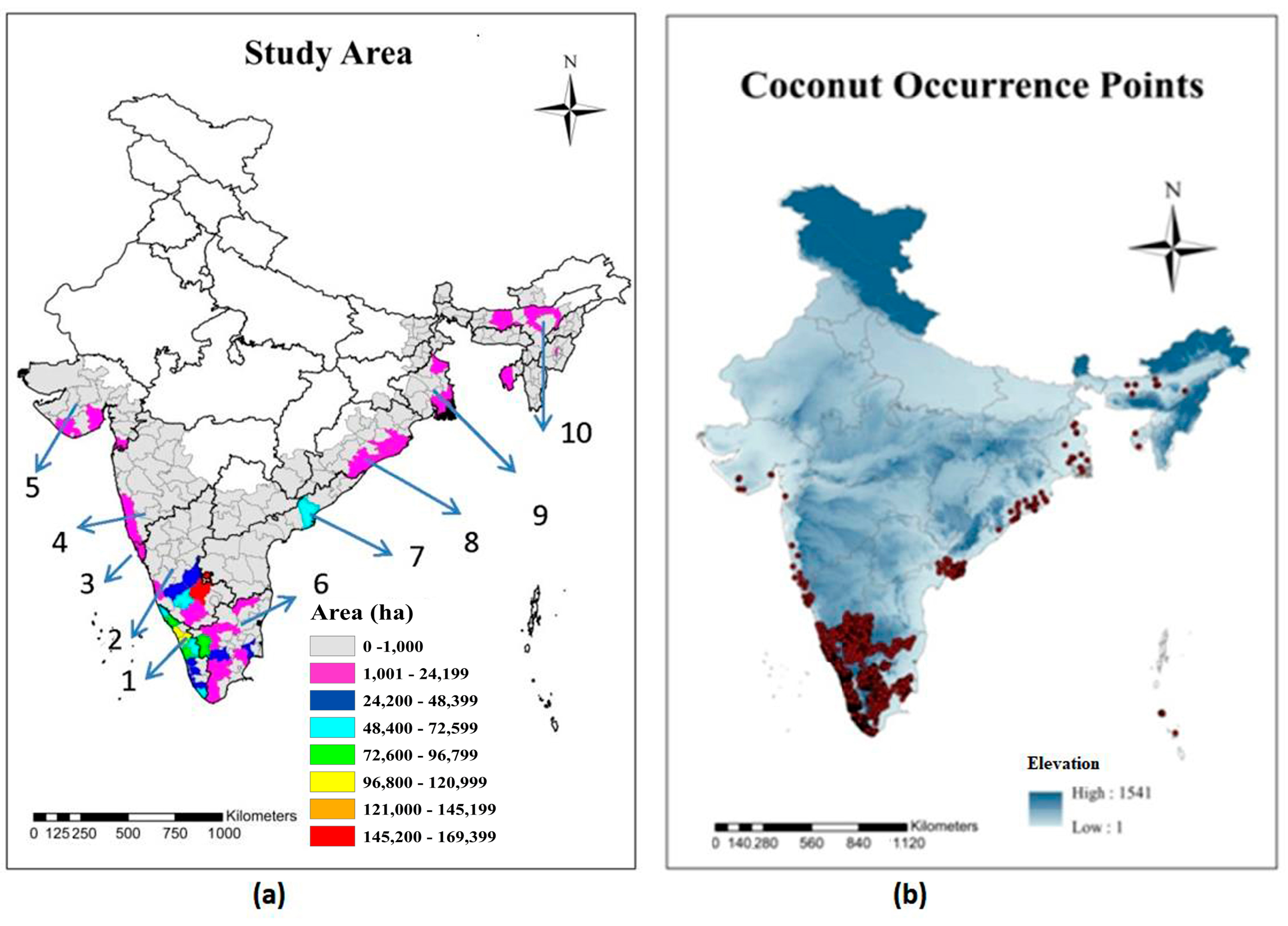
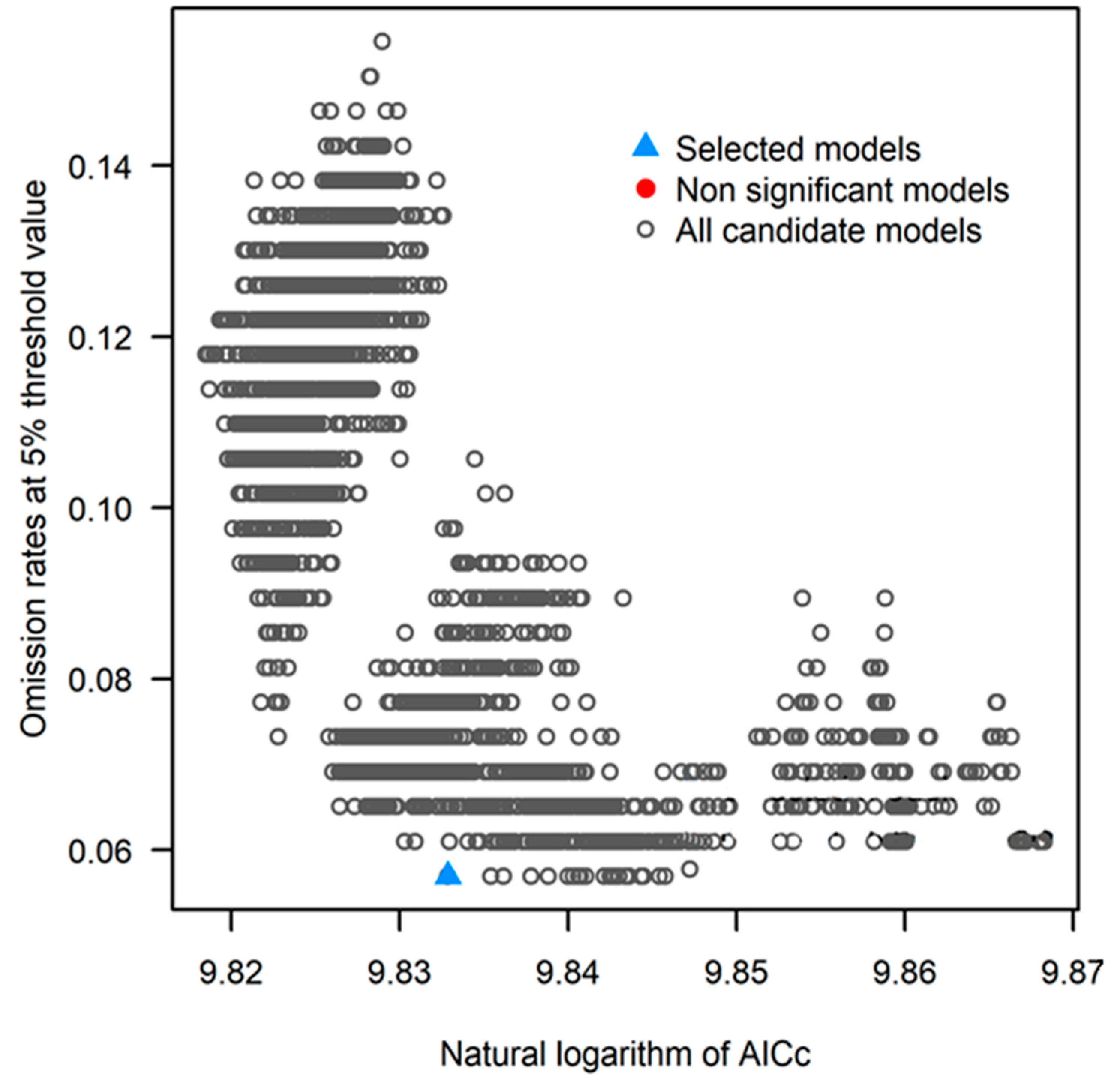

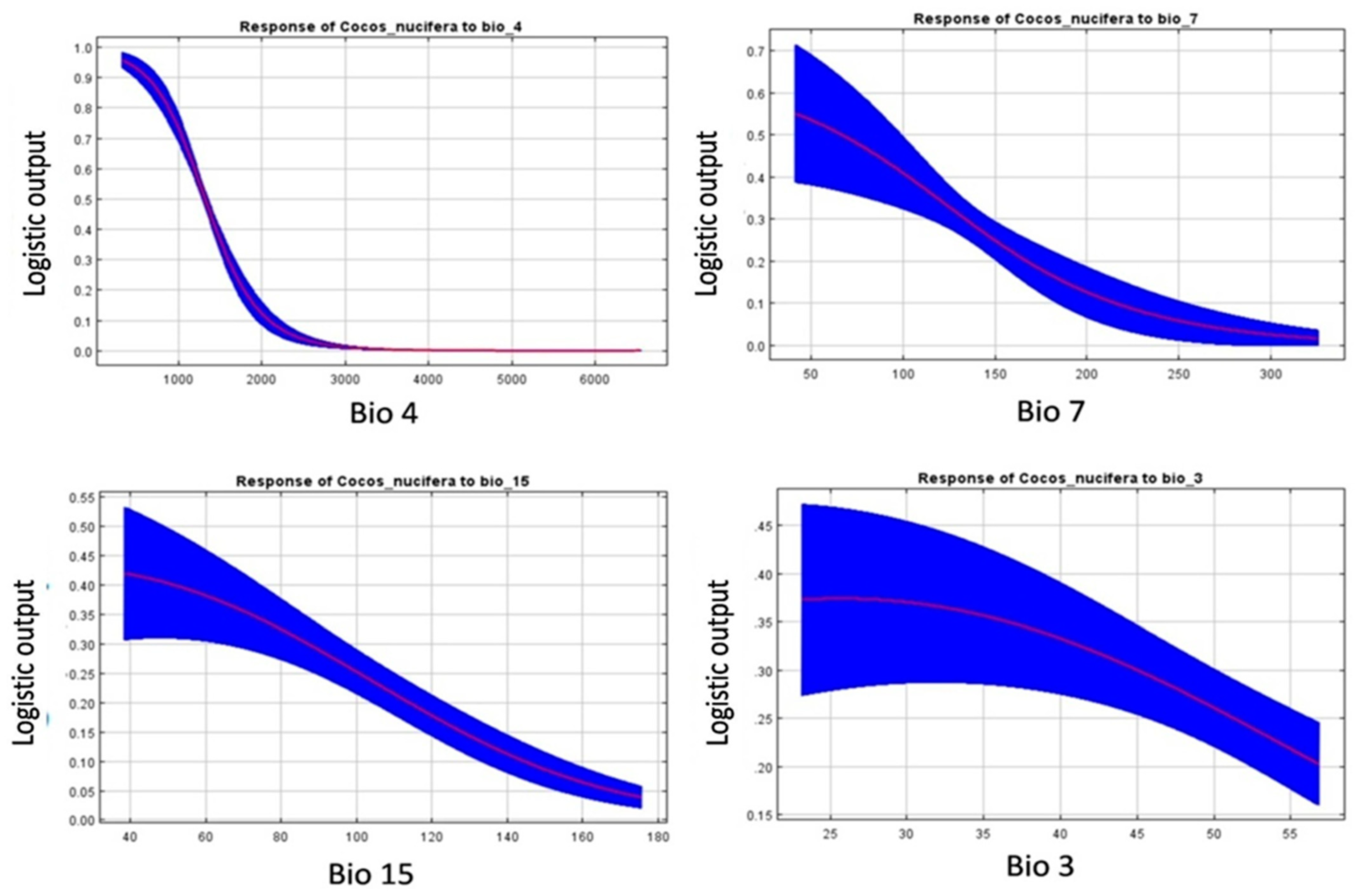
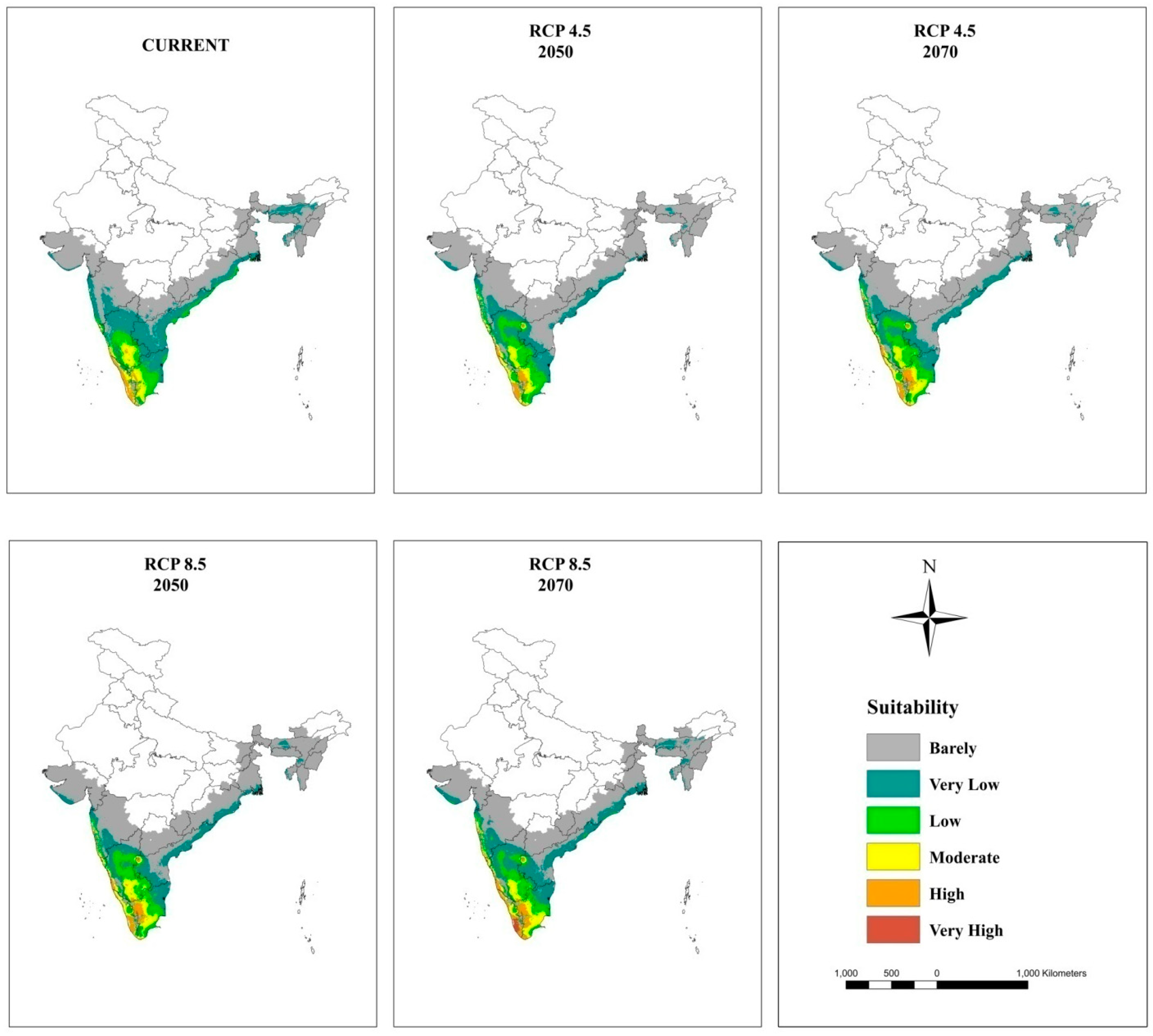

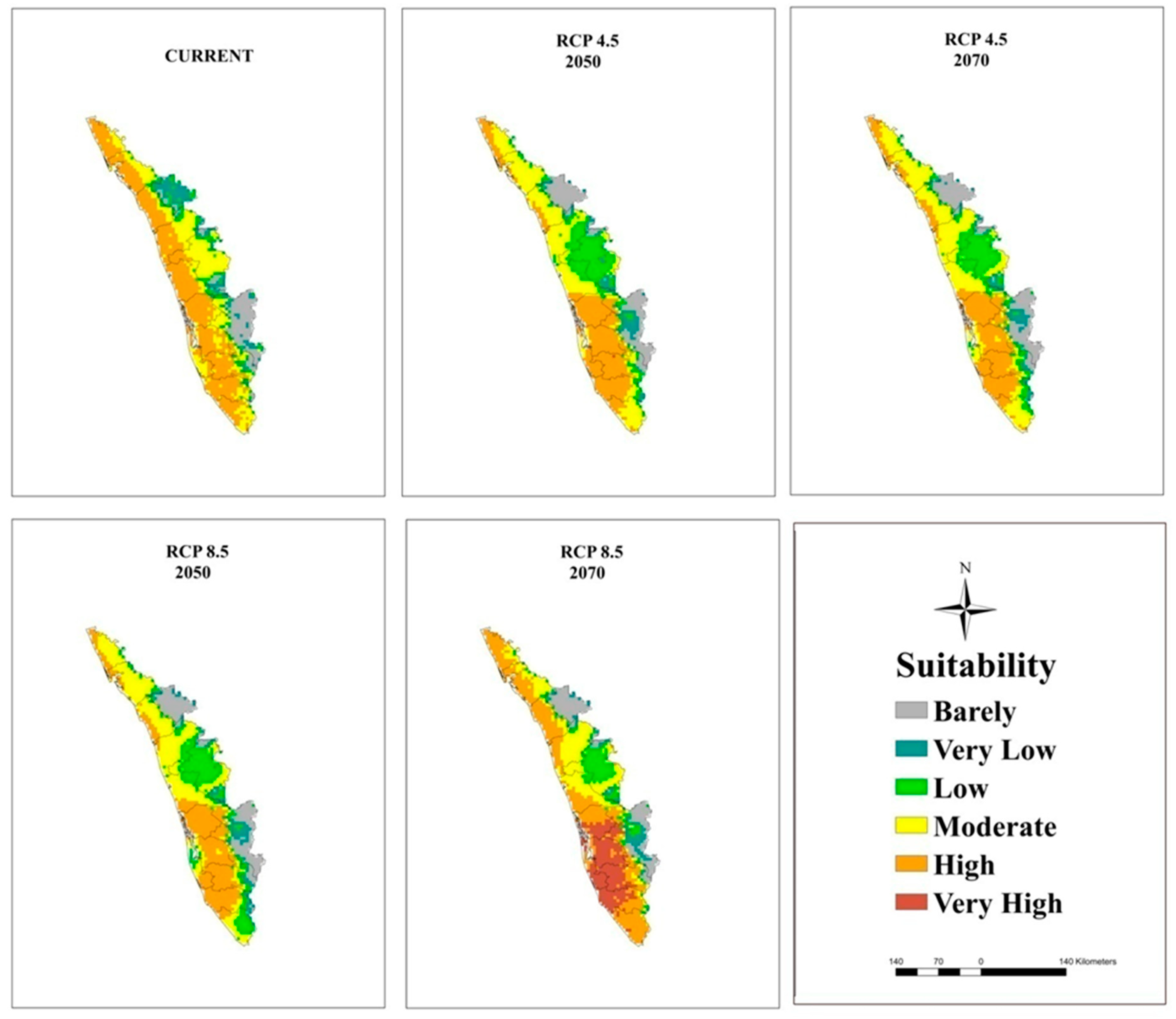
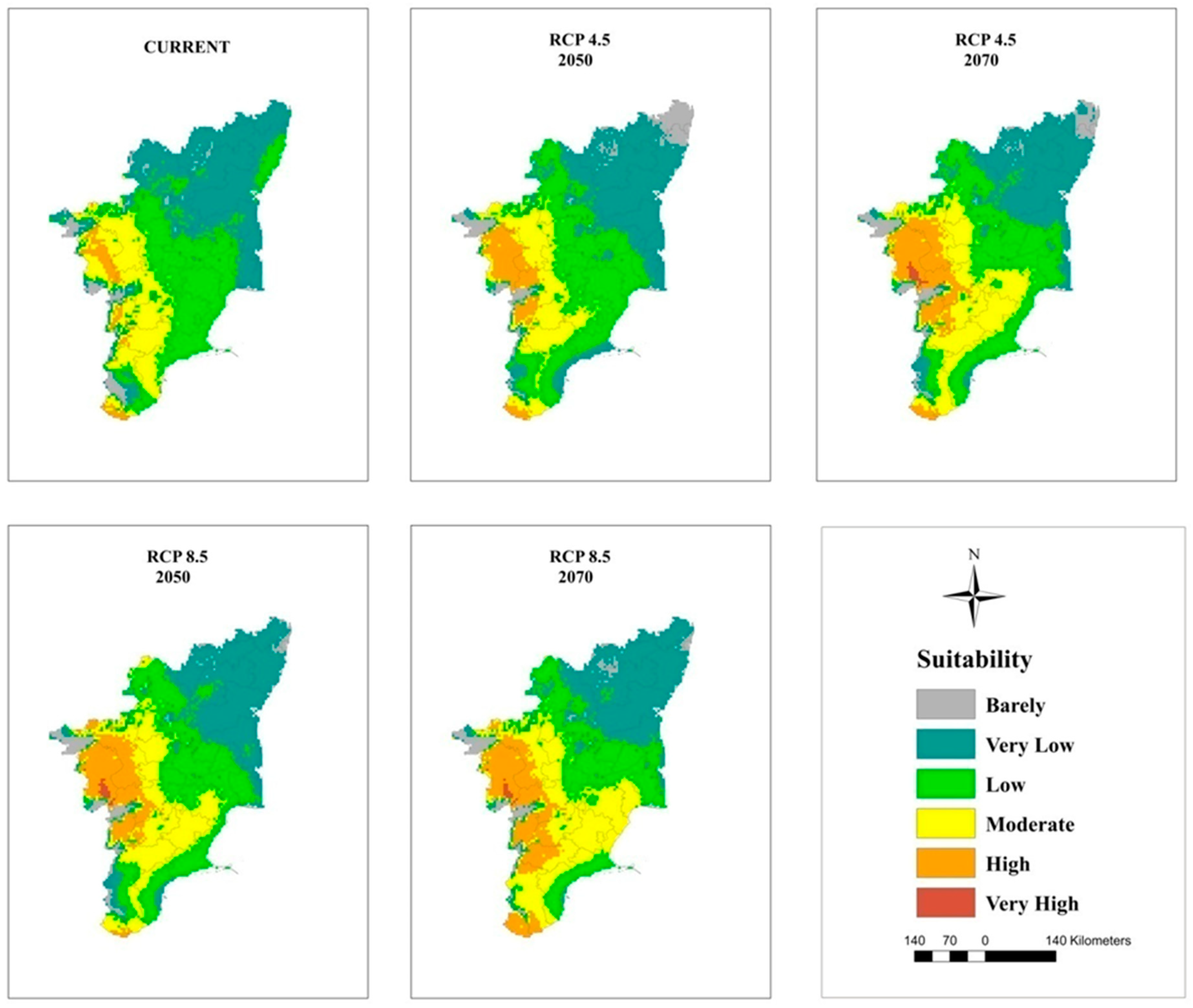
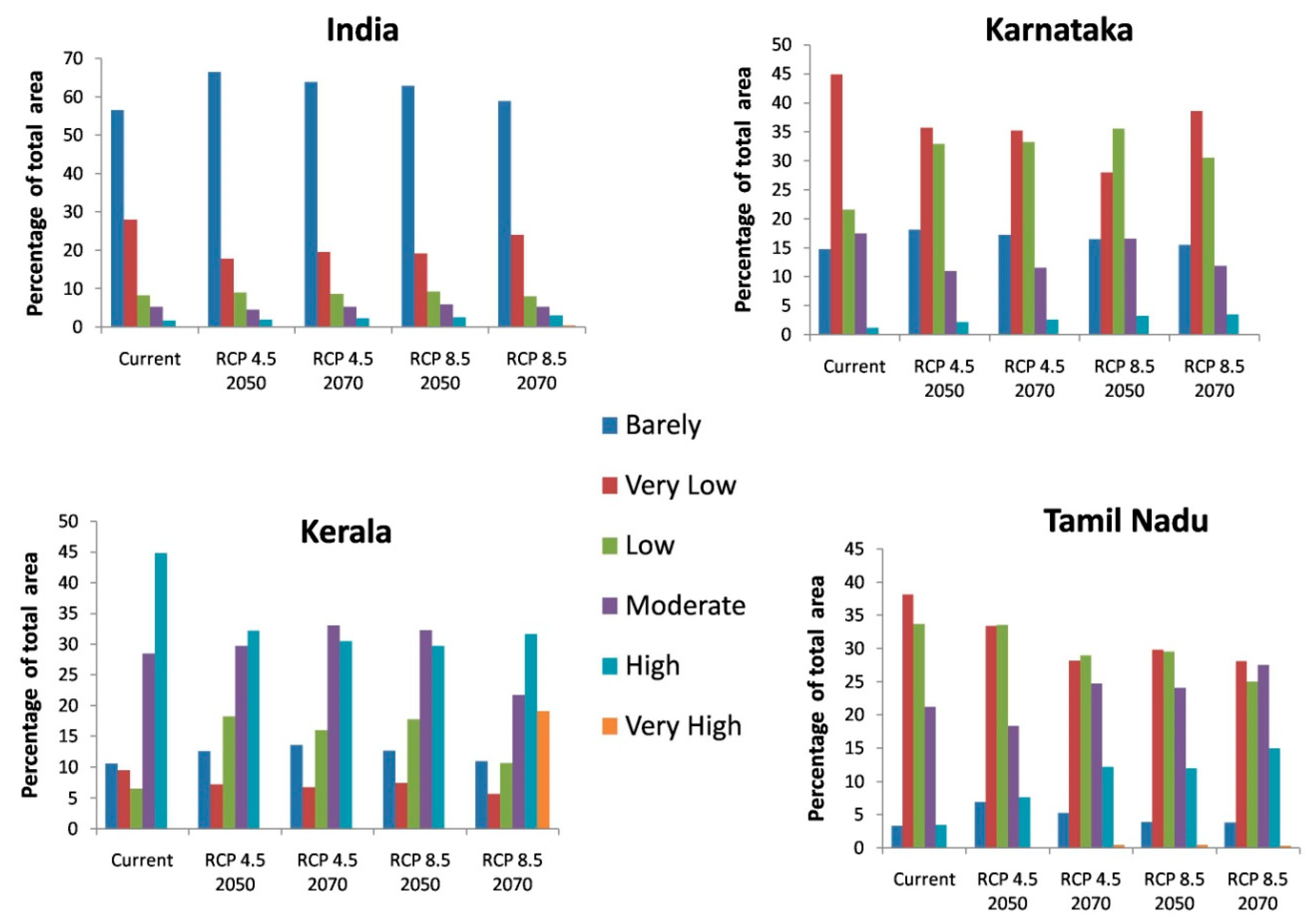
| State | Area (000 ha) | Major Districts | Area (000 ha) | Latitude | Longitude | Soil Type | Temperature Range (°C) | Humidity (%) (Range) | Precipitation (mm) | Occurrence Points | |
|---|---|---|---|---|---|---|---|---|---|---|---|
| Minimum | Maximum | ||||||||||
| Kerala | 761 | Kozhikode | 112.80 | 11.2588° N | 75.7804° E | Alluvial, lateritic | 16.9–24 | 28.2–36 | 46–92 | 3592 | 51 |
| Malappuram | 105.09 | 11.0510° N | 76.0711° E | Loamy | 12–24.2 | 23.7–36 | 44–94 | 2877 | 60 | ||
| Kannur | 85.97 | 11.8745° N | 75.3704° E | Sandy loam to clay | 18.1–23.8 | 30–36 | 45–95 | 3831 | 51 | ||
| Thrissur | 80.58 | 12.4996° N | 74.9869° E | Sandy loam to sandy | 17–24.2 | 29.8–34 | 53–99 | 3162 | 44 | ||
| Kasaragod | 67.08 | 12.4996° N | 74.9869° E | Red sandy loam, sandy | 20.2–23.8 | 31.5–36 | 36–93 | 4245 | 38 | ||
| Karnataka | 619 | Tumkur | 157.37 | 13.3379° N | 77.1173° E | Red loamy & black | 15–17.4 | 31–37.1 | 11–90 | 554 | 89 |
| Hassan | 52.32 | 13.0033° N | 76.1004° E | -do- | 14.8–17.7 | 30–36 | 34–94 | 1276 | 36 | ||
| Chikkmagaluru | 40.93 | 13.3161° N | 75.7720° E | Clay loam | 11.8–18.3 | 28–36 | 33–93 | 2019 | 28 | ||
| Chitradurga | 40.80 | 14.2251° N | 76.3980° E | Red sandy loam | 15.7–17.8 | 33.9–38 | 11–90 | 508 | 27 | ||
| D. Kannada | 20.39 | 12.8438° N | 75.2479° E | Laterite & sandy loam | 13.9–23.2 | 28–35.2 | 36–93 | 4089 | 10 | ||
| Tamil Nadu | 436 | Coimbatore | 87.41 | 11.0168° N | 76.9558° E | Sandy loam | 10.2–20.9 | 23.7–38 | 23–95 | 1149 | 48 |
| Thiruppur | 60.33 | 11.1085° N | 77.3411° E | Loamy & alluvial | 10.2–20.9 | 23.7–38 | 23–95 | 1149 | 30 | ||
| Thanjavur | 37.33 | 10.7870° N | 79.1378° E | Sandy | 21.1–23.3 | 34.4–41 | 30–91 | 850 | 24 | ||
| Dindigul | 29.22 | 10.3624° N | 77.9695° E | Loamy & Sandy loam | 8.6–20.5 | 22.5–41 | 29–90 | 1015 | 25 | ||
| Kanyakumari | 24.10 | 8.0883° N | 77.5385° E | Saline & Coastal | 16.4–24.2 | 25.7–36 | 47–95 | 1254 | 15 | ||
| Andhra Pradesh | 111 | E. Godavari | 52.30 | 17.3213° N | 82.0407° E | Red clay & alluvial | 13–22.2 | 31.3–42 | 30–93 | 1274 | 12 |
| W. Godavari | 22.09 | 16.9174° N | 81.3399° E | Alluvial & sandy alluvial | 15.6–21.3 | 34.5–43 | 49–98 | 1166 | 36 | ||
| Category Units | Sources | Variables | Abbreviations | Units | % Contribution |
|---|---|---|---|---|---|
| Bioclimatic | WorldClim—Global Climate Data http://www.worldclim.org/, accessed on 22 May 2020 Paleoclim.org | Annual mean temperature | BIO1 | °C | 1.0 |
| Mean diurnal range | BIO2 | °C | 3.1 | ||
| Isothermality | BIO3 | unitless | 5.6 | ||
| Temperature seasonality | BIO4 | unitless | 34.4 | ||
| Max. temperature of warmest month | BIO5 | °C | |||
| Min. temperature of coldest month | BIO6 | °C | 4.4 | ||
| Temperature annual range | BIO7 | °C | 28.7 | ||
| Mean temp of wettest quarter | BIO8 | °C | |||
| Mean temp of driest quarter | BIO9 | °C | |||
| Mean temp of warmest quarter | BIO10 | °C | |||
| Mean temp of coldest quarter | BIO11 | °C | |||
| Annual precipitation | BIO12 | mm | 2.0 | ||
| Precipitation of wettest month | BIO13 | mm | |||
| Precipitation of driest month | BIO14 | mm | 4.2 | ||
| Precipitation seasonality | BIO15 | unitless | 8.6 | ||
| Precipitation of wettest quarter | BIO16 | mm | |||
| Precipitation of driest quarter | BIO17 | mm | |||
| Precipitation of warmest quarter | BIO18 | mm | 1.1 | ||
| Precipitation of coldest quarter | BIO19 | mm | 2.2 | ||
| Topographical | http://www.fao.org/soils, accessed on 22 May 2020 | Soil | unitless | 0.4 | |
| http://due.esrin.esa.int/page_globcover.php, accessed on 22 May 2020 | Land cover | unitless | 0.7 | ||
| https://cgiarcsi.community/data/srtm, accessed on 22 May 2020 | Elevation | meter | 3.5 |
| Layer | Bio 1 | Bio 2 | Bio 3 | Bio 4 | Bio 5 | Bio 6 | Bio 7 | Bio 8 | Bio 9 | Bio 10 | Bio 11 | Bio 12 | Bio 13 | Bio 14 | Bio 15 | Bio 16 | Bio 17 | Bio 18 | Bio 19 | Soil | Land Cover | Elevation |
|---|---|---|---|---|---|---|---|---|---|---|---|---|---|---|---|---|---|---|---|---|---|---|
| Bio 1 | 1.000 | |||||||||||||||||||||
| Bio 2 | 0.178 | 1.000 | ||||||||||||||||||||
| Bio 3 | 0.359 | 0.117 | 1.000 | |||||||||||||||||||
| Bio 4 | −0.322 | 0.325 | −0.798 | 1.000 | ||||||||||||||||||
| Bio 5 | 0.848 | 0.620 | 0.257 | −0.075 | 1.000 | |||||||||||||||||
| Bio 6 | 0.820 | −0.197 | 0.649 | −0.761 | 0.537 | 1.000 | ||||||||||||||||
| Bio 7 | −0.051 | 0.827 | −0.450 | 0.751 | 0.405 | −0.553 | 1.000 | |||||||||||||||
| Bio 8 | 0.787 | 0.137 | −0.120 | 0.190 | 0.622 | 0.396 | 0.185 | 1.000 | ||||||||||||||
| Bio 9 | 0.864 | 0.117 | 0.651 | −0.614 | 0.707 | 0.895 | −0.272 | 0.480 | 1.000 | |||||||||||||
| Bio 10 | 0.936 | 0.397 | 0.173 | −0.058 | 0.944 | 0.631 | 0.248 | 0.782 | 0.739 | 1.000 | ||||||||||||
| Bio 11 | 0.886 | 0.026 | 0.657 | −0.706 | 0.698 | 0.968 | −0.359 | 0.454 | 0.939 | 0.741 | 1.000 | |||||||||||
| Bio 12 | −0.362 | −0.563 | −0.277 | −0.021 | −0.569 | −0.207 | −0.338 | −0.199 | −0.368 | −0.464 | −0.303 | 1.000 | ||||||||||
| Bio 13 | −0.226 | −0.433 | −0.119 | −0.167 | −0.389 | −0.067 | −0.311 | −0.167 | −0.172 | −0.335 | −0.126 | 0.913 | 1.000 | |||||||||
| Bio 14 | −0.303 | −0.529 | −0.040 | −0.038 | −0.524 | −0.091 | −0.419 | −0.218 | −0.300 | −0.403 | −0.237 | 0.289 | 0.041 | 1.000 | ||||||||
| Bio 15 | 0.183 | 0.393 | −0.085 | 0.131 | 0.338 | −0.056 | 0.395 | 0.253 | 0.167 | 0.264 | 0.067 | 0.016 | 0.315 | −0.560 | 1.000 | |||||||
| Bio 16 | −0.249 | −0.464 | −0.163 | −0.128 | −0.419 | −0.094 | −0.311 | −0.171 | −0.213 | −0.351 | −0.162 | 0.946 | 0.993 | 0.090 | 0.256 | 1.000 | ||||||
| Bio 17 | −0.309 | −0.556 | −0.164 | 0.056 | −0.536 | −0.149 | −0.367 | −0.156 | −0.363 | −0.398 | −0.296 | 0.343 | 0.062 | 0.948 | −0.582 | 0.120 | 1.000 | |||||
| Bio 18 | −0.537 | −0.371 | −0.457 | 0.389 | −0.664 | −0.528 | −0.084 | −0.156 | −0.613 | −0.543 | −0.613 | 0.666 | 0.393 | 0.400 | −0.265 | 0.456 | 0.447 | 1.000 | ||||
| Bio 19 | 0.001 | −0.339 | 0.262 | −0.395 | −0.162 | 0.244 | −0.425 | −0.149 | 0.148 | −0.142 | 0.178 | 0.452 | 0.541 | 0.039 | 0.094 | 0.535 | 0.017 | −0.039 | 1.000 | |||
| Soil | −0.361 | −0.158 | −0.302 | 0.242 | −0.315 | −0.318 | 0.034 | −0.205 | −0.383 | −0.304 | −0.376 | 0.083 | 0.030 | 0.218 | −0.103 | 0.039 | 0.257 | 0.099 | −0.043 | 1.000 | ||
| Land Cover | −0.267 | −0.086 | −0.147 | 0.151 | −0.290 | −0.269 | 0.004 | −0.118 | −0.270 | −0.277 | −0.290 | 0.237 | 0.167 | 0.160 | 0.046 | 0.182 | 0.163 | 0.266 | 0.102 | 0.061 | 1.000 | |
| Elevation | −0.809 | 0.051 | 0.017 | 0.032 | −0.555 | −0.537 | 0.034 | −0.902 | −0.556 | −0.727 | −0.563 | 0.039 | −0.003 | 0.108 | −0.197 | 0.002 | 0.056 | 0.165 | −0.005 | 0.239 | 0.128 | 1.000 |
| Criteria | Number_of_Models |
|---|---|
| All candidate models | 2480 |
| Statistically significant models | 2480 |
| Models meeting omission rate criteria | 0 |
| Models meeting AICc criteria | 2 |
| Statistically significant models meeting omission rate criteria | 0 |
| Statistically significant models meeting AICc criteria | 2 |
| Statistically significant models meeting omission rate and AICc criteria | 0 |
| Selected model | M_0.1_F_qp |
| Statistics of the selected model | |
| Mean AUC ratio | 1.501 |
| Rate of omission > 0.05% | 0.057 |
| AICc | 18,636.44 |
| Delta AICc | 0 |
| Bio Variable | Country/State | Current | RCP 4.5 | RCP 8.5 | ||
|---|---|---|---|---|---|---|
| 2050s | 2070s | 2050s | 2070s | |||
| Bio 1 (°C) | India | 25.64 | 27.37 (1.73) | 27.78 (2.14) | 27.85 (2.21) | 28.94 (3.3) |
| Andhra Pradesh (AP) | 27.37 | 29.15 (1.77) | 29.54 (2.16) | 29.41 (2.04) | 30.51 (3.14) | |
| Karnataka | 25.55 | 27.05 (1.49) | 27.40 (1.84) | 27.53 (1.97) | 28.64 (3.08) | |
| Tamil Nadu (TN) | 27.26 | 28.96 (1.70) | 29.30 (2.04) | 29.43 (2.17) | 30.44 (3.18) | |
| Kerala | 26.13 | 27.59 (1.46) | 27.94 (1.81) | 28.08 (1.95) | 29.00 (2.86) | |
| Bio 3 (%) | India | 40.79 | 47.44 (6.65) | 47.64 (6.85) | 47.60 (6.81) | 47.30 (6.51) |
| AP | 42.33 | 46.79 (4.46) | 47.32 (4.99) | 46.92 (4.59) | 46.39 (4.06) | |
| Karnataka | 45.32 | 53.18 (7.86) | 53.28 (7.96) | 53.21 (7.89) | 52.49 (7.17) | |
| TN | 48.97 | 56.03 (7.06) | 56.61 (7.64) | 56.18 (7.21) | 54.77 (5.80) | |
| Kerala | 47.61 | 61.63 (14.02) | 62.12 (14.51) | 62.25 (14.64) | 62.17 (14.56) | |
| Bio 4 (%) | India | 29.79 | 31.37 (1.58) | 30.93 (1.14) | 31.1 (1.31) | 31.34 (1.55) |
| AP | 26.27 | 29.48 (3.21) | 28.89 (2.62) | 28.62 (2.35) | 29.66 (3.39) | |
| Karnataka | 20.85 | 21.96 (1.11) | 21.84 (0.99) | 22.27 (1.42) | 23.39 (2.54) | |
| TN | 19.37 | 21.39 (2.02) | 20.83 (1.46) | 21.3 (1.93) | 22.28 (2.91) | |
| Kerala | 10.76 | 11.74 (0.98) | 11.64 (0.88) | 11.87 (1.11) | 12.35 (1.59) | |
| Bio 7 (°C) | India | 20.09 | 22.05 (1.96) | 22.03 (1.91) | 21.85 (1.76) | 21.87 (1.78) |
| AP | 18.12 | 20.50 (2.38) | 20.26 (2.14) | 19.86 (1.75) | 20.12 (2.00) | |
| Karnataka | 18.20 | 19.45 (1.26) | 19.27 (1.08) | 19.33 (1.14) | 19.56 (1.37) | |
| TN | 14.64 | 16.10 (1.45) | 15.80 (1.16) | 15.96 (1.32) | 16.42 (1.77) | |
| Kerala | 10.72 | 11.88 (1.16) | 11.65 (0.94) | 11.71 (0.99) | 11.86 (1.14) | |
| Bio 15 (%) | India | 103.8 | 106.3 (2.5) | 104.3 (0.5) | 105.6 (1.8) | 107.7 (3.9) |
| AP | 88.59 | 92.54 (3.95) | 91.45 (2.86) | 92.14 (3.55) | 94.41 (5.82) | |
| Karnataka | 98.44 | 101.39 (2.95) | 99.41 (0.97) | 100.55 (2.11) | 103.38 (4.94) | |
| TN | 76.81 | 83.24 (6.43) | 79.65 (2.84) | 81.5 (4.69) | 84.65 (7.84) | |
| Kerala | 90.35 | 87.02 (−3.33) | 83.02 (−7.33) | 85.79 (−4.56) | 87.01 (−3.34) | |
| Country/State | Category | Area (km2) | ||||
|---|---|---|---|---|---|---|
| Current | RCP 4.5 | RCP 8.5 | ||||
| 2050 | 2070 | 2050 | 2070 | |||
| India (Study area) | Range expansion | 52,617 (3.8%) | 61,642 (4.4%) | 75,383 (5.4%) | 65,164 (4.7%) | |
| Unsuitable | 1,184,077 (85%) | 1,131,238 (81.2%) | 1,122,212 (80.5%) | 1,108,471 (79.6%) | 1,118,691 (80.3%) | |
| Suitable | 209,374 (15%) | 161,776 (11.6%) | 168,738 (12.1%) | 173,169 (12.4%) | 172,036 (12%) | |
| Range contraction | 47,578 (3.4%) | 40,616 (2.9%) | 36,184 (2.6%) | 37,317 (2.7%) | ||
| Karnataka | Range expansion | 27,956 (14.5%) | 28,348 (14.7%) | 38,858 (20.2%) | 24,880 (12.9%) | |
| Unsuitable | 11,4714 (60) | 86,759 (45.1%) | 86,366 (44.9%) | 75,857 (39.4%) | 89,835 (46.7%) | |
| Suitable | 77,591 (40) | 60,723 (31.6%) | 62,994 (32.8%) | 67,846 (35.3%) | 63,448 (33.0%) | |
| Range contraction | 16,869 (8.8%) | 14,597 (7.6%) | 9745 (5.1%) | 14,143 (7.4%) | ||
| Kerala | Range expansion | 1051 (2.8%) | 798 (2.2%) | 1009 (2.7%) | 1807 (4.9%) | |
| Unsuitable | 7439 (20%) | 6388 (17.3%) | 6640 (17.9%) | 6430 (17.4%) | 5631 (15.2%) | |
| Suitable | 29,565 (80%) | 28,599 (77.3%) | 28,641 (77.4%) | 28,536 (77.1%) | 28,998 (78.4%) | |
| Range contraction | 967 (2.6%) | 925 (2.5%) | 1030 (2.8%) | 567 (1.5%) | ||
| Tamil Nadu | Range expansion | 9804 (7.5%) | 15,346 (11.8%) | 15,283 (11.7%) | 16,144 (12.4%) | |
| Unsuitable | 54,141 (42%) | 44,337 (34.0%) | 38,795 (29.7%) | 38,858 (29.8%) | 37,998 (29.1%) | |
| Suitable | 76,289 (58%) | 67,997 (52.1%) | 71,356 (54.7%) | 71,041 (54.5%) | 72,531 (55.6%) | |
| Range contraction | 8292 (6.4%) | 4933 (3.8%) | 5248 (4.0%) | 3758 (2.9%) | ||
Publisher’s Note: MDPI stays neutral with regard to jurisdictional claims in published maps and institutional affiliations. |
© 2022 by the authors. Licensee MDPI, Basel, Switzerland. This article is an open access article distributed under the terms and conditions of the Creative Commons Attribution (CC BY) license (https://creativecommons.org/licenses/by/4.0/).
Share and Cite
Hebbar, K.B.; Abhin, P.S.; Sanjo Jose, V.; Neethu, P.; Santhosh, A.; Shil, S.; Prasad, P.V.V. Predicting the Potential Suitable Climate for Coconut (Cocos nucifera L.) Cultivation in India under Climate Change Scenarios Using the MaxEnt Model. Plants 2022, 11, 731. https://doi.org/10.3390/plants11060731
Hebbar KB, Abhin PS, Sanjo Jose V, Neethu P, Santhosh A, Shil S, Prasad PVV. Predicting the Potential Suitable Climate for Coconut (Cocos nucifera L.) Cultivation in India under Climate Change Scenarios Using the MaxEnt Model. Plants. 2022; 11(6):731. https://doi.org/10.3390/plants11060731
Chicago/Turabian StyleHebbar, Kukkehalli Balachandra, Pulloott Sukumar Abhin, Veliyathukudy Sanjo Jose, Poonchalikundil Neethu, Arya Santhosh, Sandip Shil, and P. V. Vara Prasad. 2022. "Predicting the Potential Suitable Climate for Coconut (Cocos nucifera L.) Cultivation in India under Climate Change Scenarios Using the MaxEnt Model" Plants 11, no. 6: 731. https://doi.org/10.3390/plants11060731
APA StyleHebbar, K. B., Abhin, P. S., Sanjo Jose, V., Neethu, P., Santhosh, A., Shil, S., & Prasad, P. V. V. (2022). Predicting the Potential Suitable Climate for Coconut (Cocos nucifera L.) Cultivation in India under Climate Change Scenarios Using the MaxEnt Model. Plants, 11(6), 731. https://doi.org/10.3390/plants11060731









